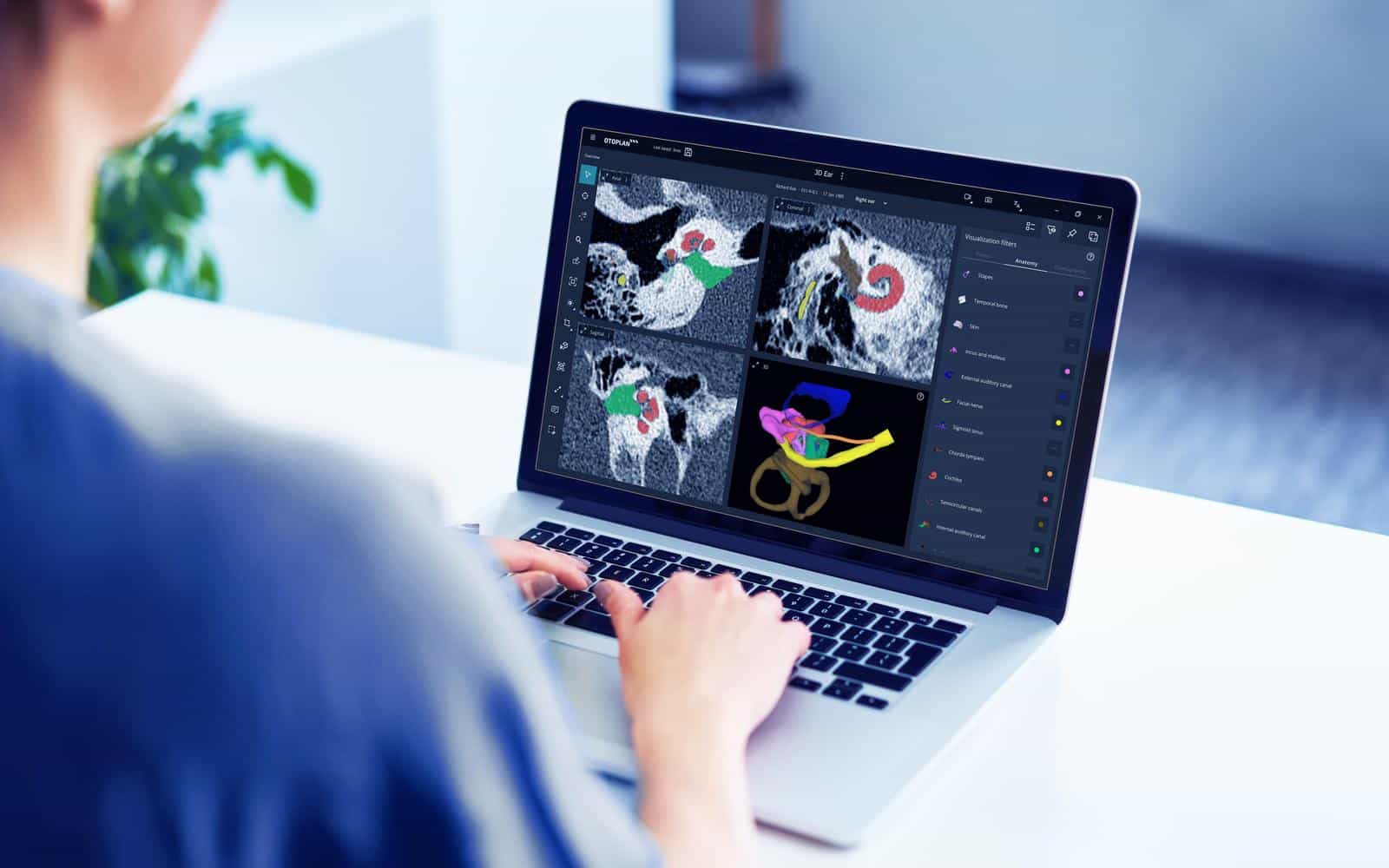
MED-EL
Published Aug 14, 2024 | Oct 16, 2025
Everything You Need to Know About Anatomy-Based Fitting
Every ear is different. So every CI fitting should be different. Enter anatomy-based fitting—one key to individualized cochlear implants.

Cochlear implant technology is constantly developing. One of the newest innovations is anatomy-based fitting (sometimes known as place-based mapping). But what exactly is it? Let’s take a look at this exciting new technology and see how it can help cochlear implant users get the most out of their hearing.
What Is Anatomy-Based Fitting?
You’ve probably heard of a cochlear implant fitting. It’s where your audiologist activates your cochlear implant after surgery. When they do this, they match your CI to your specific hearing needs and create a program or “map.” These maps are then saved to your audio processor.
Anatomy-based fitting takes this one step further. It lets your audiologist offer a more personalized and fine-tuned fitting so you can have the best hearing experience possible.
How Will It Help Me Hear?
Every ear is unique. The cochlea—the snail-like structure in the inner ear—comes in different lengths, widths, and heights. Much like a fingerprint, it’s never the same as anyone else’s.
But the cochlea is also the key to everything we hear. When you hear a high-pitched sound, like birdsong, it stimulates the beginning of your cochlea. In comparison, a low-pitched dog bark activates cells deep in your cochlea.
When you use a cochlear implant, it’s the electrode array—the long, flexible tail of the implant— that stimulates these different locations in your ear. To experience closest to natural hearing, it’s important that this electrode fits your unique cochlea. We offer multiple electrode arrays so your surgeon can choose the one that best fits your unique anatomy.

“We want to consider individual anatomy in the fitting process and by that move from cochlear implants as they are fitted today to individualized CI so that each individual cochlea, each individual patient, is really treated as individual as he or she is.”
Peter Nopp
Director of Research – Signal Processing, MED-EL
Anatomy-based fitting makes this approach even more individualized. With it, your audiologist can see the location where each pitch is stimulated so they can create a precise, personalized map that fits your cochlea. This helps deliver even closer to natural hearing. The result? It can be easier for your brain to adjust to your new implant, and how you perceive music and speech can improve.
In short, with the right length electrode fitted to your unique cochlea, you can get the most out of your cochlear implant.
How Does Anatomy-Based Fitting Work?
Anatomy-based fitting is made possible by doing a CT scan or post-op x-ray after your CI surgery. This is then imported into OTOPLAN. This software is used by surgeons to plan cochlear implant surgery and choose the right cochlear implant electrode for you. OTOPLAN then uses an algorithm that lets audiologists see the exact location of each electrode after it has been implanted. This data can then be imported into MED-EL’s fitting software, where it helps your audiologist perform a fitting that works with your unique anatomy.
It’s a bit like tuning the strings on a guitar. Anatomy-based fitting creates a map that matches the natural pitches in your cochlea more precisely.
What Does a Cochlear Implant Sound Like?
Discover what hearing with a CI can sound like with this cochlear implant sound simulation. Compare a long electrode array to a short electrode array. And hear how natural an individualized fitting can sound.
Try It Out
I Already Have a MED-EL CI. Can I Still Get Anatomy-Based Fitting?
Yes! Anatomy-based fitting is compatible with all multichannel cochlear implants as far back as 1994. However, it is only possible with SONNET 2, SONNET 2 EAS, SONNET 3, SONNET 3 EAS, and RONDO 3 audio processors.
How Do Cochlear Implant Users Find It?
Study results are generally positive. One recent study looked at experienced bilateral cochlear implant users (people with a CI on both sides). The results showed that anatomy-based fitting improved their understanding of speech. They also reported experiencing better sound quality. And a Chinese study showed that anatomy-based fitting led to better hearing outcomes.
Where Can I Get It Done?
Since this is a new technology, it might not be available at your local clinic. If you’re interested in it, ask your audiologist for more information, or contact your local MED-EL team.
Contact UsReferences

MED-EL
Was this article helpful?
Thanks for your feedback.
Sign up for newsletter below for more.
Thanks for your feedback.
Please leave your message below.
Thanks for your message. We will reply as soon as possible.
Send us a message
Field is required
John Doe
Field is required
name@mail.com
Field is required
What do you think?
© MED-EL Medical Electronics. All rights reserved. The content on this website is for general informational purposes only and should not be taken as medical advice. Contact your doctor or hearing specialist to learn what type of hearing solution suits your specific needs. Not all products, features, or indications are approved in all countries.
Charles Branson
August 14, 2024
Sure hoping for Much Improved hearing in Right (Cochlear) ear!
Anne Buxton
August 14, 2024
Sounds interesting. I have SSD in one ear since 31 years and wear HA in the other ear. I am looking into a CI for the deaf ear, would this benefit me in a better result to hear again and stimulate my dormant acoustic nerve in a better way?
MED-EL
August 16, 2024
Hi Anne, thank you for reaching out. We recommend getting in touch with your medical specialists to assess how ABF can help your hearing. We also recommend getting in touch with your local MED-EL team for any further assistance: https://www.medel.com/contact-med-el Kind regards, Gordana
Judit
October 14, 2024
I am Ssd since an ear infection 8months ago.I was operated on july activated with basic program. The sounds were muffled but in the first week my speech understanding was really good.Then on the second mapping I asked for an anatomy based mapping. Sincs the some of the sounds more natural but my speach understanding is very bad, sound like evetything is shifted to a Lower frecvency. I am on my 4th week since then but i think it is not as good as it was with my first general settinga. I would stay with this ct based if it will be better results long term. Will be help to set to my good ear? What would you suggest?
MED-EL
October 15, 2024
Judit, thank you for sharing your experience with your cochlear implant and anatomy-based fitting. We would recommend getting in touch with your local MED-EL team as they can take a direct look at your case and assist you. You can get in touch with your local MED-EL team here: https://www.medel.com/contact-med-el Kind Regards
Shirley Northrup
November 27, 2024
When will the Sonnet 3 be available in Canada?
MED-EL
November 28, 2024
Hi Shirley, thank you for reaching out. We recommend getting in touch with your local MED-EL team directly for further information on availability in Canada. Please contact them via https://www.medel.com/en-ca/contact-med-el Kind regards
Kathy Paulin
October 07, 2025
I am in the middle of this process. I had my CT scan last week. My audiologist was out of the office but had advised she would send the results to MedEl this week. I am anxiously awaiting their recommendations. Thanks to MedEl for providing this!
MED-EL
October 09, 2025
Hi Kathy, thank you for reaching out. We wish you all the best on your hearing journey and are here in case you have any questions. Kind regards, Gordana
Robert Heddle
October 23, 2025
Hello, I am a bilateral CI Am I correct in thinking that an anatomy based fitting would involve surgery to replace the implants? Thankyou PS I’m a retired surgeon
MED-EL
October 24, 2025
Hi Robert, thank you for reaching out. No, anatomy-based fitting does not require another surgery. If you have cochlear implants from MED-EL and the clinic you go to uses OTOPLAN, anatomy-based fitting could be an option for you. Your local MED-EL team is best equipped to assist you in this case as they have access to your patient data. We recommend contacting them via https://www.medel.com/contact-med-el Kind regards

MED-EL

MED-EL



Conversation
6 Comments